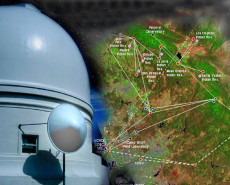NERSC Helps Nearby Supernova Factory Discover Supernovae at a Rate of Eight per Month
September 6, 2003

A special link in the High Performance Wireless Research and Education Network (HPWREN) transmits images from the Near Earth Asteroid Tracking program (NEAT) at Mount Palomar to NERSC for storage and processing for the SNfactory. (Select image to enlarge.)
The Nearby Supernova Factory based at Berkeley Lab has discovered 34 supernovae during its first year of operation and 99 to date — the best performance ever for a "rookie" supernova search. This remarkable discovery rate of eight per month is made possible by a high-speed data link, custom data pipeline software, and NERSC's ability to store and process 50 gigabytes of data every night.
The SNfactory processed a quarter-million images in its first year and archived 6 terabytes (trillion bytes) of compressed data at the National Energy Research Scientific Computing Center (NERSC) at Berkeley Lab — one of the few centers with an archive large enough to store this much data.
The SNfactory's goal is to find and examine in detail up to 300 nearby Type Ia supernovae, many more than have been studied so far. Knowing more about nearby supernovae will help scientists put observations of very distant supernovae to better use in understanding the history of the universe — particularly the mysterious dark energy that is causing the universe to expand at an accelerating rate.
Contributing to the SNfactory's remarkable discovery rate is its custom-developed "data pipeline" software. The pipeline fills with up to 50 gigabytes (billion bytes) of data a night from wide-field cameras built and operated by the Jet Propulsion Laboratory's Near Earth Asteroid Tracking program (NEAT). NEAT uses remote telescopes at Mount Palomar Observatory in Southern California and at the U.S. Air Force's Maui Space Surveillance System on Mount Haleakala.
With the help of the High Performance Wireless Research and Education Network (HPWREN) program at the San Diego Supercomputer Center (SDSC), the SNfactory was able to establish a custom-built, high-speed link with Mount Palomar. Existing links to Maui and to SDSC through the DOE's Energy Sciences Network (ESnet), complete the connection to NERSC.
A special link in the High Performance Wireless Research and Education Network (HPWREN) transmits images from the Near Earth Asteroid Tracking program (NEAT) at Mount Palomar to NERSC for storage and processing for the SNfactory.
NEAT sends images of about 500 square degrees of the sky to NERSC each night. The data pipeline software developed by UC Berkeley graduate student Michael Wood-Vasey automatically archives these in NERSC's High Performance Storage System (HPSS). NEAT's telescopes revisit the same regions of the sky roughly every six days during a typical 18-day observing period. When a supernova appears in one of those galaxies, the SNfactory can find it using image subtraction software that can sift through billions of objects. This analysis is done using NERSC's 390-processor PDSF Linux cluster.
Eventually the pipeline will automate the entire discovery and confirmation process. Once a supernova is discovered from the Palomar or Maui images, follow-up observations will be obtained via remote control of a custom-built dual-beam optical spectrograph (being completed by SNfactory collaborators in France) mounted on the University of Hawaii's 88-inch telescope on Mauna Kea. The Hawaii observations will be shipped by Internet for image processing at a supercomputing center in France and then sent to NERSC for analysis.
Astronomers and physicists depend on distant Type Ia supernovae as "standard candles" to study the ancient universe because of their exceeding brightness and remarkably similar optical characteristics. A few dozen distant Type Ia's were enough to reveal in 1998 that the universe is expanding at an accelerating rate. At present, astronomers can determine the distance to a well-studied Type Ia supernova with an accuracy of 8 percent, an accuracy the SNfactory expects to improve. The goal is to establish a much better sample of nearby Type Ia supernovae, against which the brightness of distant supernovae can be compared to obtain relative distances. Researchers also want to measure the intrinsic colors of a Type Ia at every stage, so they will know the effects of intervening dust. And they want to know what difference the "metallicity" of the home galaxy makes — that is, the presence of elements heavier than helium.
At 40 galaxies per image, the NEAT images are more likely to include metal-poor galaxies overlooked by other nearby supernova searches, as well as galaxies "in the Hubble flow" — those whose redshifts are better indicators of their distance than closer galaxies, whose redshifts may be disturbed by the gravitational pull of their neighbors.
A recent major discovery made possible by the SNfactory was the first detection of hydrogen in the form of circumstellar material around a supernova — in this case, SN 2002ic, discovered near maximum light by the SNfactory. Researchers have been looking for hydrogen to discriminate between different types of possible progenitor systems to Type Ia supernovae. Large amounts of hydrogen around SN 2002ic suggest that the progenitor system contained a massive asymptotic giant branch star that lost several solar masses of gas in a "stellar wind" in the millenia leading up to the Type Ia explosion.
About Computing Sciences at Berkeley Lab
High performance computing plays a critical role in scientific discovery. Researchers increasingly rely on advances in computer science, mathematics, computational science, data science, and large-scale computing and networking to increase our understanding of ourselves, our planet, and our universe. Berkeley Lab’s Computing Sciences Area researches, develops, and deploys new foundations, tools, and technologies to meet these needs and to advance research across a broad range of scientific disciplines.







 Instagram
Instagram YouTube
YouTube